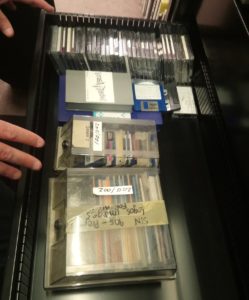Too often, this is what media art history of the last 30 years looks like: a bunch of disks in a drawer.
Australian digital media arts heritage is at risk. Australian artists were significant contributors to the development of media arts internationally, yet only a relatively small portion of their work has to date made it into institutional collections. Materials has been scattered, held in the archives of organisations with no conservation resources, or in artists’ own archives. Many artists have lost the ability to access their own artworks; few have the skills and equipment to comprehensively self-archive. And disks are degrading, reliant on obsolete hardware and software.
As well as aiming to develop a good practice method for stabilising artworks from selected case studies, and providing emulated access to the artworks to researchers in reading rooms and other things, this project aims – as per our subtitle — to form a picture of the distributed national media arts collection in Australia.
The research is intended to address a local knowledge gap, and to build a more comprehensive picture of the distributed national media arts collection. It is also collecting information for an infrastructure bid to conduct imaging of unstable media at scale.
Several community-based, often artist run organisations were pioneers of the media arts scene in Australia: dLux Media Arts, Experimenta Media Arts, the Australian Network for Art and Technology (now known as ANAT), and Griffith Artworks. Whilst these organisations have undergone multiple changes of identity, their archives present a remarkably coherent picture of the development of media arts in Australia. Archiving is not the ‘core business’ of media arts organisations. Aware of the riches these archives hold, I have been lobbying for them to find secure, ‘jurisdictionally appropriate’ homes for a number of years.
Over the past few years, these archives have found homes in cultural organisations: dLux Media Arts has gone to the Art Gallery of NSW; Experimenta’s media archive is with the Australian Centre for the Moving Image; Griffith Artworks evolved to become Griffith University Art Museum; and the State Library of South Australia has taken the archive of ANAT (was the Australian Network for Art and Technology). They also hold the archive of the significant Polish-Australian media artist, Stan Ostoja-Kotkowski.
The preservation and emulation parts of our project will take a deep dive into specific case studies, artworks and exhibitions. But as archivist Louise Curham observed in her dLux “Significance Assessment”, taken together, the archives of ANAT, Experimenta, and dLux constitute an invaluable and extremely rich record (2015). The collections provide context for — and enrich — each other.
There is significant geographic spread, but good reason to view these archives as part of a broader national collection. We gain a lot by considering the collections together. This principle can be pushed quite far, I think: while objects may be housed in different institutions in different states, they are really part of a larger, national – and in many cases, public — collection.
It can often seem like there isn’t much media artwork held within cultural institutions. But that is actually not the case. Diverse organisations hold media artworks, but no one quite knows who has what. No one knows where to look, as there is no union catalogue for galleries in Australia. Some collection databases are public, but not all. And web searches often don’t penetrate into an organisation’s database, even if it is on their website. Discoverability is a significant problem.
In 2020, we invited organisations to send us their holdings in spreadsheet form, which we are compiling into a database, here on our project website. Surveying the nation’s holdings will allow us to collate and share information about Australian media arts holdings, so as to increase discoverability. We won’t get everything of course, and real time data sharing is beyond the scope of the current project. What we are hoping for is a ‘snapshot in time’. Such information will assist researchers to discover which artworks are held by institutions and to identify any duplication, gaps in collections nationally, and items that are one-offs. We’ll continue to accept submissions for a while, so the information can be improved over time.
We are also in the process of auditing what is in the dLux, Experimenta, and ANAT archives, and will put up what information we have about these on this website as soon as possible. The information will not be complete as no one really knows what is on the archived disks until they are imaged. [Update: the list of artists in the ANAT archive are here.]
I am looking forward to a time when we will have emulation infrastructure that will allow work to be accessed from across the national collection, similar to the Yale University-led EaaSI project (Emulation as a Service Infrastructure). This is a model that suits the distributed holdings of media arts – and the geographic scale of a big country such as Australia — very well.
We are laying the groundwork for such a future national rollout of emulation infrastructure in a sister project we have underway – a game history and preservation project called “Play It Again” – in which our national not-for-profit network provider, AARNet is evaluating various configurations of Emulation as a Service, using 1990s digital games as test objects. We will also be running several standalone trials of EaaS (at ACMI, Griffith University Art Museum, and Art Gallery of NSW) in this project, to make it possible for researchers to access historic media artworks in reading rooms.
If you are part of an Australian organisation with media arts holdings, please send us a spreadsheet with the details of the artworks, so we can add it to the “Media Arts in Australian Collections” database.

